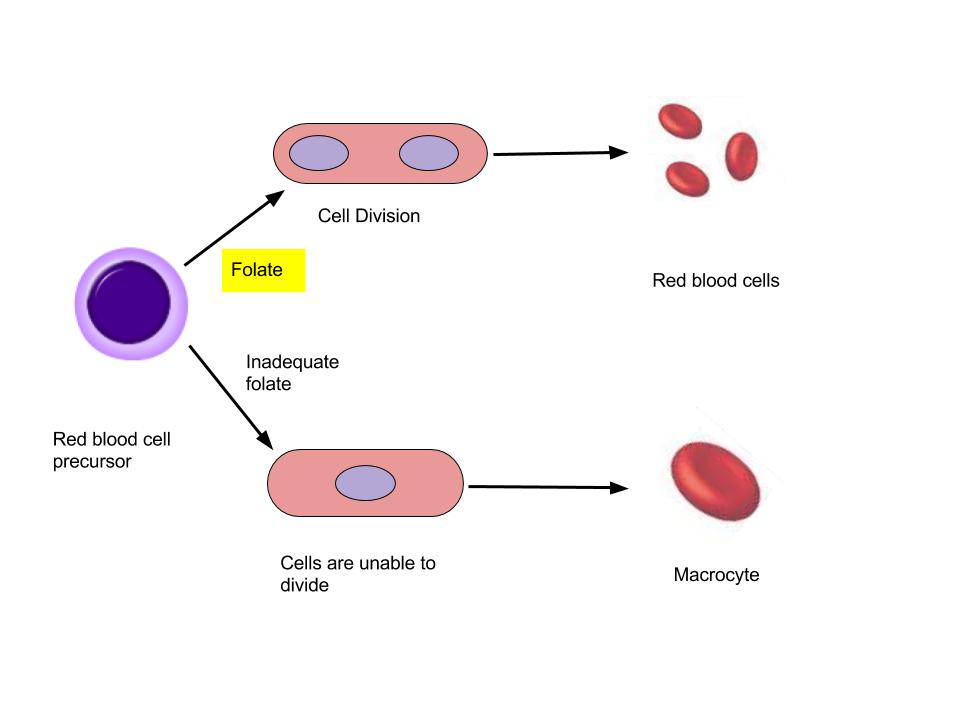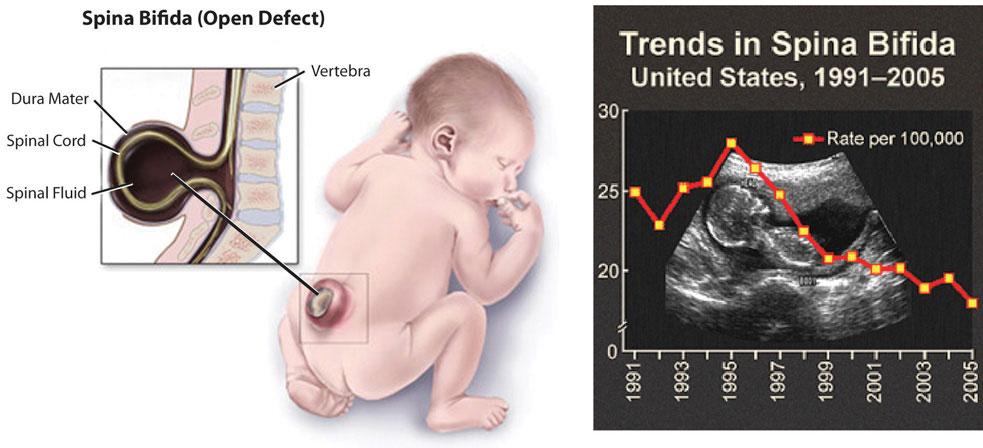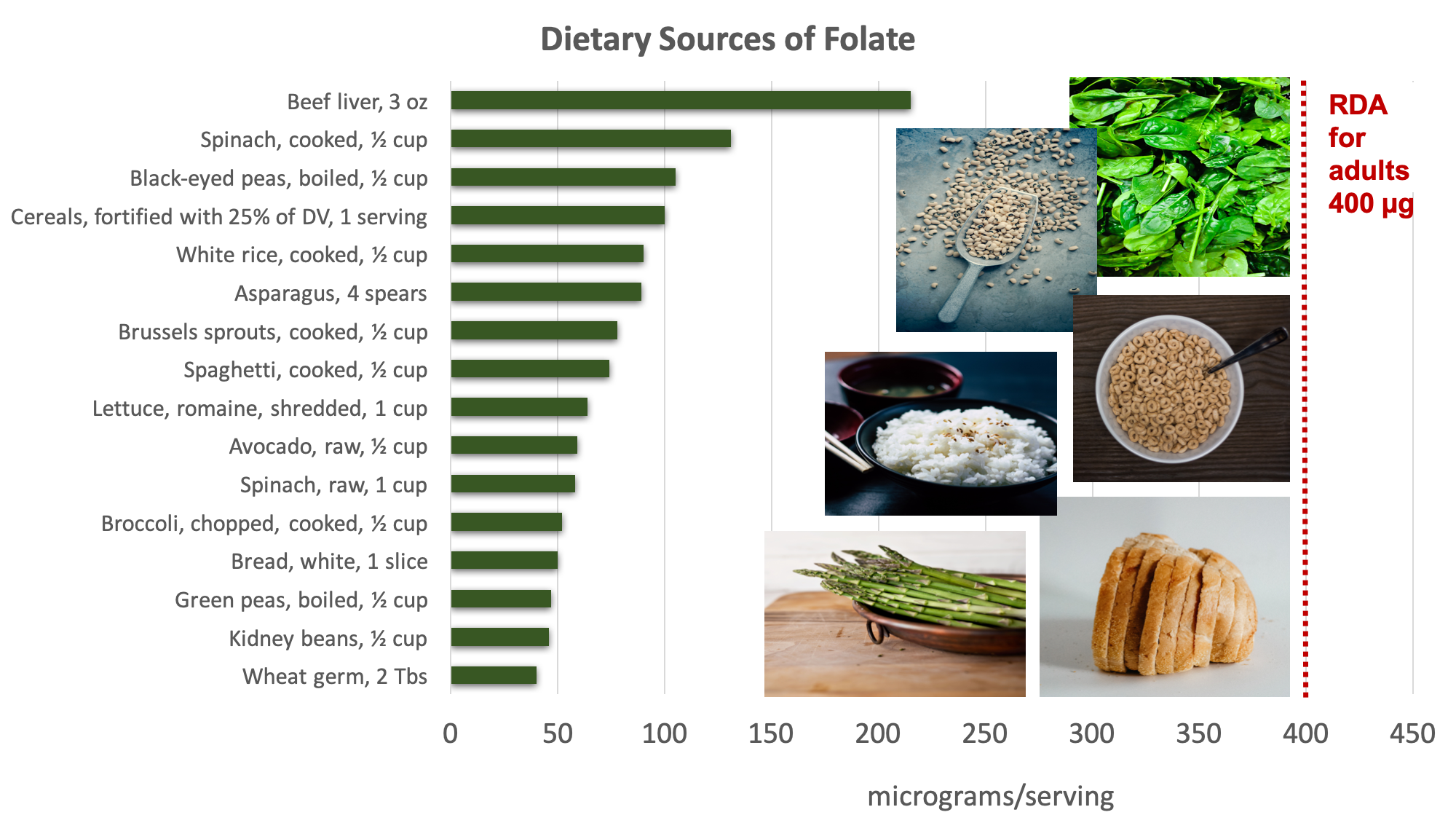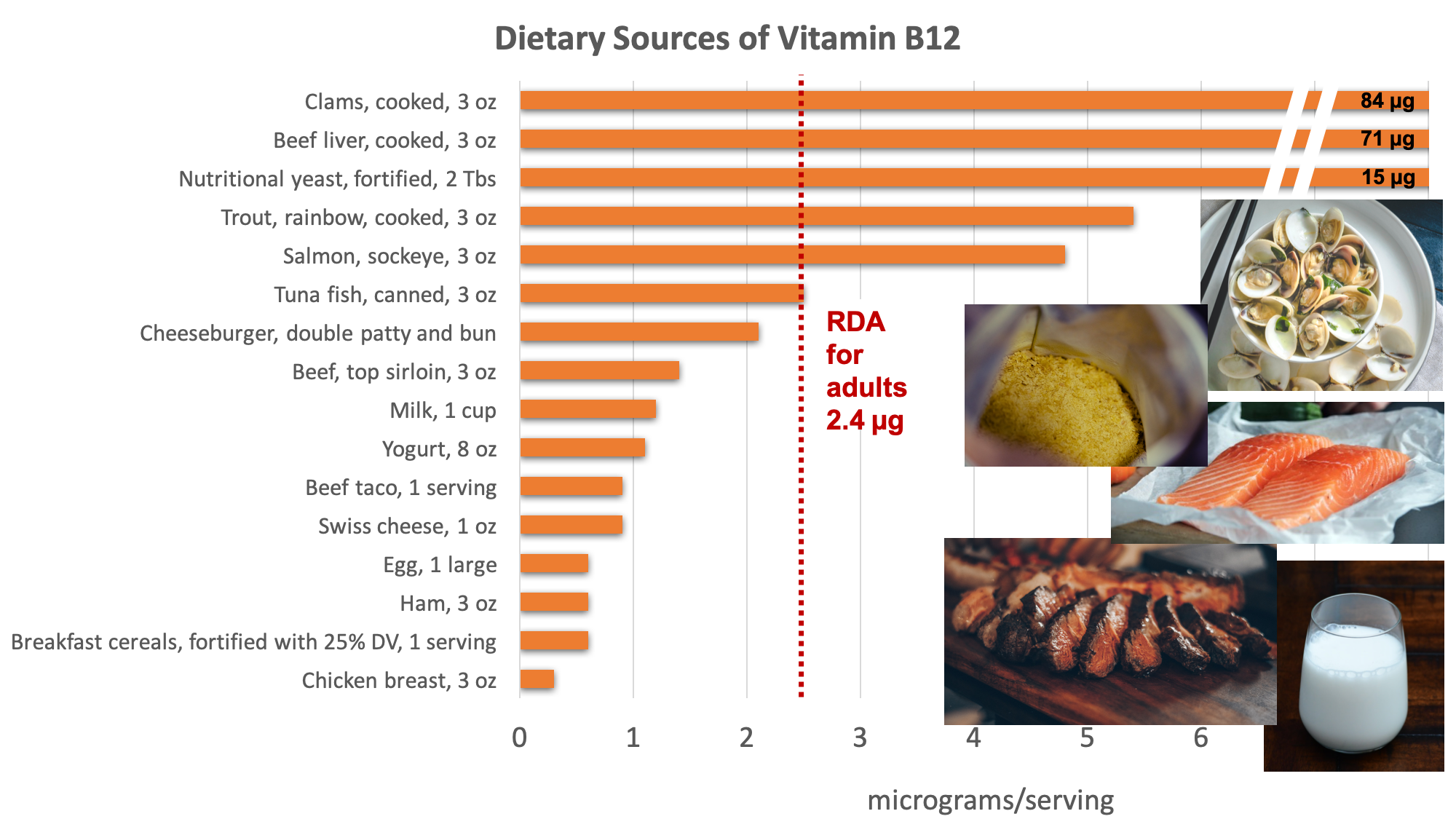55 Vitamins and Minerals Involved in Energy Metabolism
Have you ever heard that taking vitamins will give you more energy? Or have you bought a product that claimed it could boost your energy level because it has added vitamins? Based on the knowledge that you’ve learned in this course, you know that vitamins are not broken down in the body to provide energy. So where does the idea that vitamins give you energy come from? On this page we will provide an overview of the B vitamins and several minerals that are important to the process of energy metabolism in the body, and take a closer look at two of those vitamins (folate and vitamin B12) that have some important implications in our health.
The Role of B Vitamins and Minerals in Energy Metabolism
All of the B vitamins and several minerals play a role in energy metabolism; they are required as functional parts of enzymes involved in energy release and storage. Many enzymes don’t work optimally, or even at all, unless bound to other specific helper molecules, called coenzymes or cofactors. Binding to these molecules promotes optimal conformation and function for their respective enzymes.

Figure 9.14. Role of a coenzyme assisting in an enzymatic reaction to break down a substrate.
Vitamins that bind to enzymes are referred to as coenzymes—organic molecules which are required by enzymes to catalyze a specific reaction. They assist in converting a substrate to an end product. Cofactors are the inorganic minerals that assist in these enzymatic reactions. Coenzymes and cofactors are essential in catabolic pathways (i.e. breaking down substances) and play a role in many anabolic pathways (i.e. building substances). Table 9.1 lists the vitamins and minerals that participate in energy metabolism and their key functions in that process.
|
Nutrients Involved in Energy Metabolism |
|
|
B Vitamins |
Role in Energy Metabolism |
|
Thiamin (B1) |
Assists in glucose metabolism and RNA, DNA, and ATP synthesis |
|
Riboflavin (B2) |
Assists in carbohydrate and fat metabolism |
|
Niacin (B3) |
Assists in glucose, fat, and protein metabolism |
|
Pantothenic Acid (B5) |
Assists in glucose, fat, and protein metabolism, cholesterol and neurotransmitter synthesis |
|
Pyridoxine (B6*) |
Assists in the breakdown of glycogen and synthesis of amino acids, neurotransmitters, and hemoglobin |
|
Biotin (B7) |
Assists in amino acid synthesis and glucose, fat, and protein metabolism, |
|
Folate (B9) |
Assists in the synthesis of amino acids, RNA, DNA, and red blood cells |
|
Cobalamin (B12*) |
Protects nerve cells and assists in fat and protein catabolism, folate function, and red blood cell synthesis |
|
Minerals |
Role in Energy Metabolism |
|
Iodine |
Assists in metabolism, growth, development, and synthesis of thyroid hormone |
|
Manganese |
Assists in carbohydrate and cholesterol metabolism, bone formation, and the synthesis of urea |
|
Sulfur |
A component in sulfur-containing amino acids necessary in certain enzymes; a component in thiamin and biotin |
|
Chromium |
Assists in carbohydrate, lipid, and protein metabolism, DNA and RNA synthesis |
|
Molybdenum |
Assists in metabolism of sulfur-containing amino acids and synthesis of DNA and RNA |
*Normally used instead of common names
Table 9.1. Vitamins and minerals involved in energy metabolism and the role they each play.
Do B Vitamins Give You Energy?
Because B vitamins play so many important roles in energy metabolism, it is common to see marketing claims that B vitamins boost energy and performance. This is a myth that is not backed by science. The “feeling” of more energy from energy-boosting supplements stems more from the high amount of added sugars, caffeine, and other herbal stimulants that accompany the high doses of B vitamins in these products. As discussed, B vitamins are needed to support energy metabolism and growth, but taking in more than required does not supply you with more energy. A great analogy of this phenomenon is the gas in your car. Does it drive faster with a half-tank of gas or a full one? It does not matter; the car drives just as fast as long as it has gas. Similarly, depletion of B vitamins will cause problems in energy metabolism, but having more than is required to run metabolism does not speed it up. And because B vitamins are water-soluble, they are not stored in the body and any excess will be excreted from the body, essentially flushing out the added expense of the supplements.
Deficiency and Toxicity
The B vitamins important for energy metabolism are naturally present in numerous foods, and many other foods are enriched with them; therefore, B vitamin deficiencies are rare. Similarly, most of the minerals involved in energy metabolism and listed above are trace minerals that are not frequently deficient in the diet. However, when a deficiency of one of these vitamins or minerals does occur, symptoms can be seen throughout the body because of their relationship to energy metabolism, which happens in all cells of the body. A lack of these vitamins and minerals typically impairs blood health and the conversion of macronutrients into usable energy (i.e., ATP). Deficiency can also lead to an increase in susceptibility to infections, tiredness, lack of energy, and a decrease in concentration.1 Groups most at risk for a deficiency in any of these micronutrients are people on calorie-limited diets, people with imbalanced or insufficient nutrition, people with eating disorders, and people experiencing extensive levels of physical or emotional stress.1
Because of their water-solubility, toxicities of most of these nutrients are also uncommon, as excess intake is often excreted from the body. That doesn’t mean taking high doses comes without risks. Large quantities, particularly through supplements, can lead to adverse side effects or cause interactions with medications. For example, too much niacin can cause flushing of the skin or dangerous drops in blood pressure, and a high intake of B6 can lead to neuropathy. When taking vitamin or mineral supplements, always pay attention to the recommended dietary allowance and avoid exceeding the tolerable upper intake level (UL).
Folate
Folate, or vitamin B9, is a required coenzyme for the synthesis of several amino acids and for making RNA and DNA. Therefore, rapidly dividing cells are most affected by folate deficiency. Red blood cells, white blood cells, and platelets are continuously being synthesized in the bone marrow from dividing stem cells. When folate is deficient, cells cannot divide normally. A consequence of folate deficiency is macrocytic anemia. Macrocytic means “big cell,” and anemia refers to fewer red blood cells or red blood cells containing less hemoglobin. Macrocytic anemia is characterized by larger and fewer red blood cells that are less efficient at carrying oxygen to cells. It is caused by red blood cells being unable to produce DNA and RNA fast enough—cells grow but do not divide, making them large in size.

Figure 9.15. Folate and the formation of macrocytic anemia.
Folate is especially essential for the growth and specialization of cells of the central nervous system. Children whose mothers were folate-deficient during pregnancy have a higher risk of neural tube birth defects. Folate deficiency is causally linked to the development of spina bifida, a neural tube defect that occurs in a developing fetus when the spine does not completely enclose the spinal cord. Spina bifida can lead to many physical and mental disabilities (Figure 9.16). In 1998, the U.S. Food and Drug Administration (FDA) began requiring manufacturers to fortify enriched breads, cereals, flours, and cornmeal with folic acid (a synthetic form of folate) to increase the consumption of folate in the American diet and reduce the risk of neural tube defects. Observational studies show that the prevalence of neural tube defects was decreased after the fortification of enriched cereal and grain products with folate compared to before these products were fortified.

Figure 9.16. Spina bifida (left) is a neural tube defect that can have serious health consequences. The prevalence of cases of spina bifida has decreased significantly with the fortification of cereal and grain products in the United States beginning in 1998.
Additionally, results of clinical trials have demonstrated that neural tube defects are significantly decreased in the offspring of mothers who began taking folic acid supplements one month prior to becoming pregnant and throughout pregnancy. In response to the scientific evidence, the Food and Nutrition Board of the Institute of Medicine (IOM) raised the RDA for folate to 600 micrograms per day for pregnant women.
Dietary Sources of Folate
Folate is found naturally in a wide variety of foods, including vegetables (particularly dark leafy greens), fruits, nuts, beans, legumes, meat, poultry, eggs, and grains. As mentioned previously, folic acid (the synthetic form of folate) is also found in enriched foods such as grains.

Figure 9.17. Dietary sources of folate. Examples of good sources pictured include spinach, black-eyed peas, fortified cereal, rice, and bread and asparagus. Source: NIH Office of Dietary Supplements
Folate Deficiency and Toxicity
Folate deficiency is typically due to an inadequate dietary intake; however, smoking and heavy, chronic alcohol intake can also decrease absorption, leading to a folate deficiency.2 The primary sign of a folate deficiency is macrocytic anemia, characterized by large, abnormal red blood cells, which can lead to symptoms of fatigue, weakness, poor concentration, headache, irritability, and shortness of breath. Other symptoms of folate deficiency can include mouth sores, gastrointestinal distress, and changes in the skin, hair and nails. Women with insufficient folate intakes are at increased risk of giving birth to infants with neural tube defects and low intake during pregnancy has been associated with preterm delivery, low birth weight, and fetal growth retardation.3
Toxicity of folate is not typically seen due to an excess consumption from foods. However, there is concern regarding a high intake of folic acid from supplements because it could mask a deficiency in vitamin B12. Because folate and vitamin B12 deficiencies are manifested by similar anemias, if a person with vitamin B12 deficiency is taking a high dose of folic acid, the macrocytic anemia would be corrected while the underlying B12 deficiency went undetected, which could result in significant neurological damage. Thus, a tolerable upper intake level (UL) has been established for folate to prevent irreversible neurological damage due to high folic acid intake masking a B12 deficiency.2
Vitamin B12 (Cobalamin)
Vitamin B12 is a unique vitamin because it contains an element (cobalt) and is found almost exclusively in animal products. Neither plants nor animals can synthesize vitamin B12; only bacteria can synthesize it. The vitamin B12 found in animal-derived foods was produced by microorganisms within the animals. Animals consume the microorganisms in soil, or microorganisms in the GI tract of animals produce vitamin B12 that can then be absorbed.
Vitamin B12 helps to prevent the breakdown of the myelin sheath, a cover that surrounds and protects nerve cells. It is also an essential part of coenzymes. It is necessary for fat and protein catabolism, folate coenzyme function, and hemoglobin synthesis. An enzyme requiring vitamin B12 is needed by a folate-dependent enzyme to synthesize DNA. Thus, a deficiency in vitamin B12 has similar consequences to health as a folate deficiency. In children and adults, vitamin B12 deficiency causes macrocytic anemia, and in babies born to cobalamin-deficient mothers there is an increased risk for neural tube defects.
In order for the human body to absorb vitamin B12, the stomach, pancreas, and small intestine must be functioning properly. Cells in the stomach secrete a protein called intrinsic factor that is necessary for vitamin B12 absorption, which occurs in the small intestine. Impairment of secretion of this protein either caused by an autoimmune disease or by chronic inflammation of the stomach (such as that occurring in some people with H.pylori infection), can lead to the disease pernicious anemia, a type of macrocytic anemia. Vitamin B12 malabsorption is most common in older adults, who may have impaired functioning of digestive organs, a normal consequence of aging.
Vitamin B12 and folate play key roles in converting homocysteine, an amino acid found in the blood, to the amino acid methionine. High levels of homocysteine in the blood increases the risk for heart disease. Low levels of vitamin B12, folate, or vitamin B6 will increase homocysteine levels, thereby increasing the risk of heart disease.
Dietary Sources of Vitamin B12
Vitamin B12 is found naturally in animal products such as fish, meat, poultry, eggs, and milk products. Although vitamin B12 is not generally present in plant foods, fortified breakfast cereals are also a good source of vitamin B12. Because vitamin B12 is only found primarily in animal products, it is important for strict vegetarians who consume no animal products (vegans) to get vitamin B12 either through supplements, nutritional yeast, or fortified products like cereals and soy milk. Recent research suggests some plant-based sources like edible algae, mushrooms, and fermented vegetables may contain substantial amounts of vitamin B12 as well.2

Figure 9.18. Dietary sources of vitamin B12. Examples of good sources pictured include clams, salmon, nutritional yeast, red meat, and milk. Source: NIH Office of Dietary Supplements, www.bragg.com
Vitamin B12 Deficiency and Toxicity
When there is a deficiency in vitamin B12, inactive folate (from food) is unable to be converted to active folate and used in the body for the synthesis of DNA. However, folic acid from supplements or fortified foods is available to be used as active folate in the body without vitamin B12. Therefore, if there is a deficiency in vitamin B12, macrocytic anemia may occur. Vitamin B12 deficiency also results in nerve degeneration and abnormalities that can often precede the development of anemia. These include a decline in mental function and burning, tingling, and numbness of legs. These symptoms can continue to worsen, and deficiency can be fatal.4
The most common cause of vitamin B12 deficiency is the condition of inadequate intrinsic factor production that leads to poor vitamin B12 absorption, resulting in pernicious anemia. This condition is common in people over the age of 50, because production of intrinsic factor decreases with age. Pernicious anemia is treated by large oral doses of vitamin B12 or by putting the vitamin under the tongue (sublingual), where it is absorbed into the bloodstream without passing through the intestine. In patients that do not respond to oral or sublingual treatment, vitamin B12 is given by injection.
Because vitamin B12 is found primarily in foods of animal origin, a strict vegetarian diet can result in cases of vitamin B12 deficiency. Therefore, careful dietary planning to include fortified sources or supplements of vitamin B12 is important to prevent deficiency in a vegan diet.
No toxicity of vitamin B12 has been reported. Because of the low risk for toxicity, a tolerable upper intake level (UL) has not been established for vitamin B12.4
Self-Check:
Attributions:
- University of Hawai‘i at Mānoa Food Science and Human Nutrition Program, “Human Nutrition,” CC BY-NC 4.0
- Lindshield, B. L. (2018). Kansas State University Human Nutrition (FNDH 400) Flexbook. NPP eBooks. 19. http://newprairiepress.org/ebooks/19
- “Enzymes”, Introduction to Biology is licensed under CC BY-NC-SA 3.0
References:
- 1Huskisson, E., Maggini, S., & Ruf, M. (2007). The role of vitamins and minerals in energy metabolism and well-being. Journal of international medical research, 35(3), 277-289.
- 2Linus Pauling Institute-Micronutrient Information Center. (2020). Folate. Retrieved May 2, 2020 from https://lpi.oregonstate.edu/mic/vitamins/folate
- 3National Institutes of Health Office of Dietary Supplements. (2020, March 11). Folate. Retrieved May 2, 2020, from https://ods.od.nih.gov/factsheets/Folate-HealthProfessional/
- 4Linus Pauling Institute-Micronutrient Information Center. (2020). Vitamin B12. Retrieved May 2, 2020, from https://lpi.oregonstate.edu/mic/vitamins/vitamin-B12
Image Credits:
- Figure 9.14. “Role of coenzyme” by Heather Leonard is licensed under CC BY 4.0
- Table 9.1. “Vitamins and minerals involved in energy metabolism” by Heather Leonard is licensed under CC BY 4.0
- Figure 9.15. “Folate and the formation of macrocytic anemia” by Allison Calabrese is licensed under CC BY 4.0
- Figure 9.16. “Spina bifida in infants” by Centers for Disease Control and Prevention is in the Public Domain
- Figure 9.17. “Dietary sources of folate” by Alice Callahan is licensed under CC BY 4.0, with images: spinach by Nathan Nugent, black-eyed peas by Jasmine Waheed, breakfast cereal by John Matychuk, rice by Mgg Vitchakorn, asparagus by Stephanie Studer, and sliced bread by Stephanie Harvey, all on Unsplash (license information).
- Figure 9.18. “Dietary sources of vitamin B12” by Alice Callahan is licensed under CC BY 4.0, with images: Clams by Eiliv-Sonas Aceron, salmon filets by Caroline Attwood, sirloin by Emerson Vieira, glass of milk by Kim Gorga, all on Unsplash (license information); Nutritional yeast in bag by Tony Webster is licensed under CC BY 2.0.
Organic molecules required by enzymes to catalyze a specific reaction.
Inorganic minerals that assist in enzymatic reactions.
The breakdown of complex molecules into simpler molecules to generate energy.
The synthesis of larger molecules, which requires energy.
A type of anemia characterized by larger and fewer red blood cells; caused by folate deficiency.
A neural tube defect that occurs in a developing fetus when the spine does not completely enclose the spinal cord; caused by folate deficiency.
A synthetic form of folate.
A cover that surrounds and protects nerve cells and allows electrical impulses to transmit quickly and efficiently.
A protein secreted in the stomach that is necessary for vitamin B12 absorption.
A type of macrocytic anemia caused by vitamin B12 malabsorption due to lack of intrinsic factor.
An amino acid found in blood.
A strict vegetarian who consumes no animal products.

